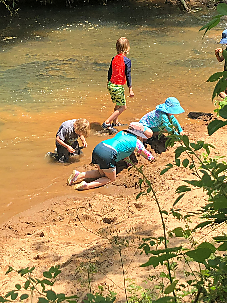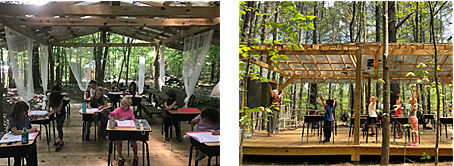Spring is the air in my part of the world, which is bringing everyone outside to enjoy the sun, work in the yard, get their gardens ready, and just have fun.
But at The Garden School in Marietta, GA, they don’t wait for spring. They are outdoors year-round in almost any weather. (Granted, that’s easier in Georgia than Pennsylvania.)
A few months ago, the Friday Feature profiled Barefoot University, which is a forest school for homeschoolers that meets once a week. It’s a great option that helps get kids learning outside and appreciating the world around them.
The Garden School uses the forest school approach combined with a Waldorf-inspired curriculum in a full-time setting. It currently operates preschool through fourth grade and has expanded one grade per year over the past several years.
I was able to tour the school recently, and it was incredible. Since I was there on a Friday, the children were enjoying “creek-cess”—recess where they get to play in the creek.
The creek isn’t just for fun, though. They study how creek life changes throughout the year, monitor water quality, and use it for hands-on lessons in a variety of subjects.
The kindergarten classrooms each include a mud kitchen and a variety of objects—like tires, logs, and ropes—the kids can use in creative play. Each of the three kindergarten areas had a different feel to it as each group of kids used the space in a different way. The age range for kindergarten is 4–6, and the focus is on play.
Academic subjects begin in first grade. Ideally, each class will be with the same teacher throughout their time at the school. This gives them a chance to work together over a long period of time and lets the teachers can really know the children and better meet their needs.
Since children concentrate best in the morning, the school day begins with a two-hour period devoted to a single academic subject. They study one topic for three or four weeks so the teacher can cover it in-depth using a variety of approaches. The curriculum slowly expands in grades 1–4 from the experiential learning of kindergarten to include more lesson work.
Third graders are in charge of the school’s farm. They create chore schedules, feed the animals, water the plants, and work on upkeep—including building a climbing gym for the goats and securing fences to keep critters out of the garden as much as possible.
Blending the Waldorf curriculum with the forest school model produces a unique atmosphere. It is academically rigorous but incorporates a lot of free play, nature study, and practical skills. The children are excited to learn, and their parents are thrilled to have such a nurturing educational environment for them.
Education can—and should—be a wonderful endeavor. For many children, options like the Garden School are just what they need to flourish.


